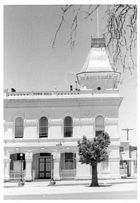By August 1851 gold had been found at Warrandyte, Clunes and Buninyong, but the rush really started with sensational finds near Ballarat, at Golden Point. From its beginnings as a makeshift diggings camp, Ballarat made a stunning transformation to emerge as a major provincial city in under two decades. Its rich deep-lead mines, its agricultural hinterland and industries ensured its longevity. By the 1880s cultural institutions like the Municipal Observatory and School of Mines show the sophistication, scientific curiosity and talent existing in Ballarat.
The fortunes of Creswick, Talbot and Clunes depended on deep-lead gold, but they did not match Ballarat’s long-term success. Creswick had an early shallow alluvial rush but the town seemed set to die until a rich alluvial deep-lead was discovered in 1872. Its elaborate Town Hall is an optimistic celebration of its rebirth. The large flour mill at Smeaton was set up by the Anderson Brothers in 1861 when the agricultural area around Creswick was flourishing. Talbot and Clunes were in decline in the 1880s. The Clunes Post Office, more like a palazzo in an Italian Renaissance town than a country post office, testifies to the town’s era of prosperity.
Some gold towns survived as administrative centres. Avoca was made the local police district under the legislation that followed Eureka. Maryborough emerged as a dominant town in the area north of Ballarat and was the site of the district gaol. The palatial Railway Station proclaimed the town’s confidence. Ararat won not only a gaol (J Ward) but also a Lunatic Asylum, Aradale.
Diggers and gold escorts from South Australia made their way through the sparsely populated Wimmera across huge pastoral runs and through small villages. Many Chinese came this way to evade the entry tax imposed on all Chinese at Victorian ports. A large group apprehended near Stawell in 1862 were sent to Ararat Gaol.
By the 1870s the Wimmera was swarming with selectors, many of them ex-miners. The golden age of wheat had commenced and would continue long after the gold had run out in other areas. Transport to distant markets was essential to success. Minyip Railway Station is evidence of the extension of the railway campaigned for by the Wimmera selectors.
From heady beginnings in the gold rush, St Arnaud and Stawell developed into stable service towns for the growing population of selectors. Stawell sandstone from Heatherlie Quarry on the edge of the nearby Grampians was used in the finely crafted Court House, as well as Melbourne buildings such as Parliament House.
The gold rush fostered the beginning of the region’s wine industry. French gold seekers planted vines at Great Western in the early 1860s and Englishman Joseph Best set up a vineyard, now Seppelts, in 1866. Local miners helped tunnel the extensive network of cellars.
Irrigation issues grew more urgent as farming intensified in the Wimmera and later, the Mallee. One irrigation scheme created a major town: Mildura. Psyche Bend Pumping Station was part of the extensive system begun by the Chaffey brothers in 1887.
This text is reproduced from the publication, 'A Golden Heritage: Victoria 150' (2001) with the kind permission of Heritage Victoria







